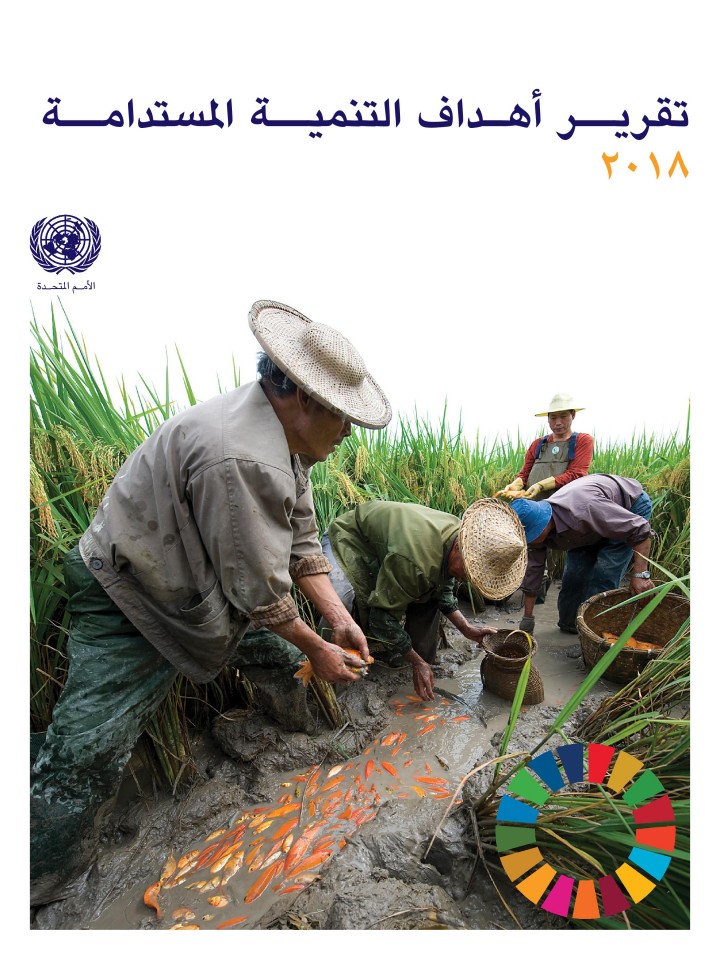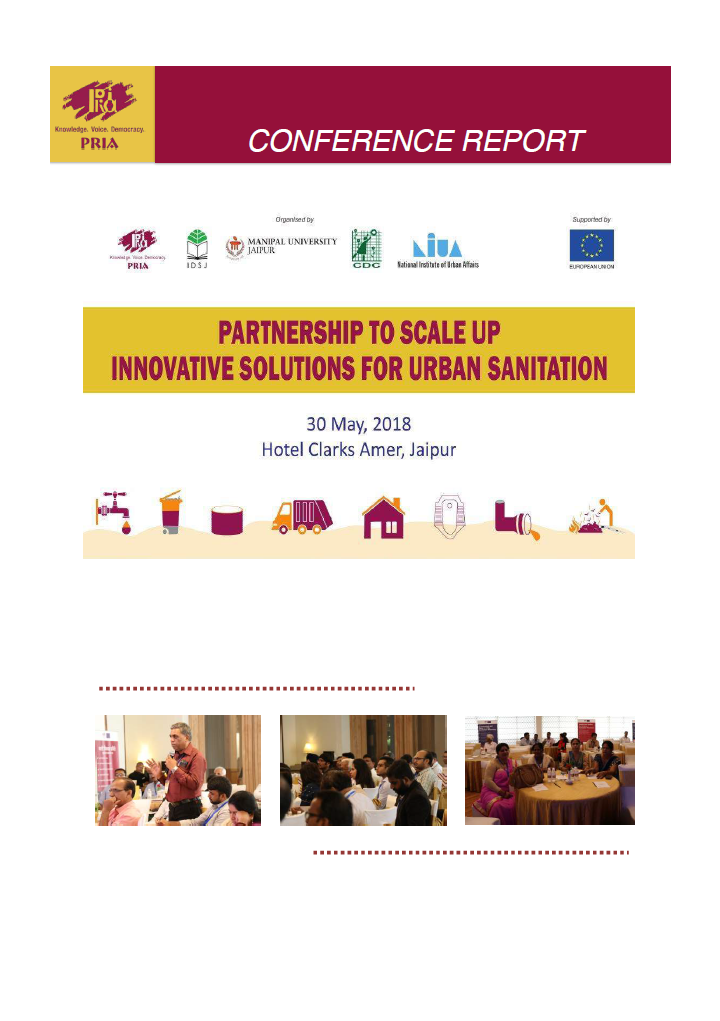ACF and WaterAid (2018) Towards effective integration of nutrition and water, sanitation and hygiene - the Madagascar experience Case study (in English and French)
The case study, ‘Towards effective integration of nutrition and WASH - the Madagascar experience’, is a collaboration between ACF and WaterAid teams in Madagascar and HQs aimed at documenting and sharing the progress and challenges Madagascar has experienced in improving coordination and integration of nutrition and WASH. It is based on in-country interviews with stakeholders involved from central and local government, NGOs and donors. It […]
USAID (2018) Scaling Market-Based Sanitation: Desk Review on Market-Based Rural Sanitation Development Programs
Inadequate access to sanitation remains a significant problem globally and is linked to the transmission of numerous communicable diseases with a disproportionately large effect on children. The scale of investment required to deliver sanitation goods and services to those who lack access is beyond the capacity of public finance alone. The private sector has already proven itself a key player in the financing, construction, and […]
الامم المتحدة ، إدارة الشؤون الاقتصادية والاجتماعية (2018) 2018 تقريــر أهـداف التنميــة المستدامة Sustainable Development Goals Report (in Arabic)
2030 اطلقت الامم المتحدة تقرير جديد حول اهداف التنمية المستدامة باللغة العربية الذي يستعرض التقدم المحرز في السنة الثالثة من تنفيذ خطة التنمية المستدامة لعام
WHO & UNICEF (2016) Core Questions and Indicators for Monitoring WASH in Schools in the SDGs
Through expert consultations, the JMP has developed core questions for monitoring water, sanitation and hygiene at home, schools and health centres. The document contains core and expanded indicators related and specific to MHM and infrastructure in schools.
Beard, V. A., Mahendra, A. and Westphal, M. I. (2016) Towards a More Equal City: Framing the Challenges and Opportunities Working Paper
This Working Papers contain preliminary research, analysis, findings, and recommendations. They are circulated to stimulate timely discussion and critical feedback and to influence ongoing debate on emerging issues. Most working papers are eventually published in another form and their content may be revised.
Abraham, B., Monse, B., Schlenk, J. & Wendland, C. (2018) Sustainable WASH in Institutions and Gender Equality Scope and Focus of Working Group 7
The scope and focus document of SuSanA Working Group (WG) 7 Sustainable WASH in Institutions and Gender Equality (Leave No One Behind – in communities, schools and other institutions) WG 7 has two goals: a. To strengthen water, sanitation, and hygiene (WASH) in schools and other institutions within community structures. To learn more about the work of WG 7 in the field of WASH in schools, see Factsheet […]
PRIA (2018) Partnership to Scale Up Innovative Solutions for Urban Sanitation Conference report
A state level Conference on Partnership to Scale Up Innovative Solutions for Urban Sanitation was organised on 30 May 2018 in Jaipur, Rajasthan. It was organised by Participatory Research in Asia (PRIA) in collaboration with National Institute of Urban Affairs (NIUA), Centre for Development Communication Jaipur, Manipal University Jaipur, and the Institute for Development Studies, Jaipur. The objectives of the conference were: • To showcase scalable innovative […]
NWASCO (2018) Rural Water Supply and Sanitation: Framework for Provision and Regulation in Zambia
In developing the framework for provision and regulation of Rural Water Supply and Sanitation Services (RWSS), the National Water and Sanitation Council of Zambia (NWASCO) was mandated to facilitate and coordinate the consultative process under the Ministry of Water Development, Sanitation and Environmental Protection (MWDSEP). The objective of this publication is to assist in the creation of a regulatory framework for rural water supply and sanitation […]
NWASCO (2018) Urban Onsite Sanitation and Faecal Sludge Management: Framework for Provision and Regulation in Zambia
In developing the framework for provision and regulation of urban onsite sanitation services, the National Water and Sanitation Council of Zambia (NWASCO) was mandated to facilitate and coordinate the consultative process under the Ministry of Water Development, Sanitation and Environmental Protection (MWDSEP). The objective of this publication is to assist in the creation of a regulatory framework for onsite sanitation and faecal sludge management that supports […]
Shafner, S. (2017) FLUSH - The Documentary
FLUSH is a documentary film raising awareness of what happens to bodily waste in America, and a growing movement to change the way we think about “waste,” premiering in honor of World Toilet Day. Raise awareness of World Toilet Day and theme “wastewater,” engage “developed” countries in a conversation about broader sanitation themes and question the wisdom of water-based toilets, create an advocacy tool for stakeholder […]
Various Authors (2018) 21st SanCoP Meeting: “Addressing the Complexities of Citywide Environmental Sanitation" Conference materials
The 21st meeting of the UK’s Sanitation Community of Practice was held on the 19th of April at the University of Leeds. The aim for the day was to engage participants in considering the links between human excreta management, solid waste management, and surface water drainage, as critical aspects of citywide environmental sanitation. As well as the traditional SanCoP focus, contributions were invited from professionals experienced […]
GIZ, LSHTM (2018) Emergency Environmental Health Forum 2018 Event Report
The Event Report of 2018’s Emergency Environmental Health Forum, which took place in Berlin, summarises all the presentations, keynote speeches, panel discussions and recent key findings from practice and academia. New research and innovations in the sanitation sector were presented and approaches elaborated that aim at bridging knowledge silos between WASH and other humanitarian sectors. The report features Parliamentary State Secretary Norbert Barthle’s welcome speech […]
Nia, A. B. (2018) Asia and the Pacific SDG Progress Report 2017
Asia and the Pacific SDG Progress Report 2017 is an assessment of the progress towards the SDG targets in Asia and the Pacific and its subregions. Drawing on the analysis of 66 indicators (60 global SDG indicators and 6 proxy indicators) the report forecasts likely progress by 2030 and identifies areas where greater effort is needed. The assessment of progress contained in this report is limited […]
GTO (2018) Young Pupils Break Toilet-Taboo Together with Parliamentary State Secretary Actions-March in Berlin’s Governmental District (in English and German)
Berlin, 4 June 2018 60% of the world population lives, according to the World Health Organization (WHO), without secure sanitation, which protects health and the environment. In line with the World Environment Day on 5 June and as a contribution to the European Sustainability Week, over 75 Berlin pupils organised an “Actions-March” in Berlin’s governmental district and demanded a “Toiletised World”. Together with the German Toilet Organization […]
Global Communities (2017) WASH for Health Communication Package Brief Designed with Extension Workers for Extension Workers to Use in Communities to Change Behaviour
The Water, Sanitation, and Hygiene (WASH) for Health (W4H) Program has put together a comprehensive package of materials for you to use in your communication sessions. These materials have been developed to help you change WASH behaviours in your communities. The following is a list of the types of materials contained in the WASH for Health Communication Package. Materials have been developed for the following […]
Global Communities (2010) Guidelines for Usage and Maintenance of KVIP Latrine
Illustrated guidelines for usage and maintenance of KVIP latrine
GNWP, UNICEF (2017) Household Latrine Selection Guide
Matrix of household latrine types/technology options
GNWP, UNICEF (2017) Latrine Technology Manual
The handbook will serve as a guide for engineers, planners, masons, carpenters, etc. e handbook will enable people to make informed choices and facilitate carpenters and masons during construction. It will also serve as a reference document for officials at the national and local government levels. Given the technical level of this resource, readers need to have a basic skill set and previous construction […]
GNWP, UNICEF (2015) Latrine Options Flyer
Various latrine options, including a Ventilated Improved Pit, Simple Pit Latrine, Kumasi Ventilated Improved Pit, Enviro Loo waterless Toilet, Composting latrine, Urine Diverting Dry Toilet, Pour-Flush Toilet without Water-Seal, Installed On Direct Pit (Ventilated Pit), Pour-flushed toilets, Pour-Flush Toilet with Water-Seal, Installed On Ventilated Pit, and Biofil Toilet.
Kenya Water Institute (2018) Kenya Water Institute Short Term Courses: Operator Course for Sewerage
The function of the department is mainly to carry surveillance on sector dynamics, conduct training needs, develop and implement short tailor made courses for skills upgrading, problem solving, and refresher in the water and related sectors. The tailor made courses are to suit the training needs and interventions desired for organizational growth in accordance with strategic plans and business environment. The courses offered are interventional […]




















